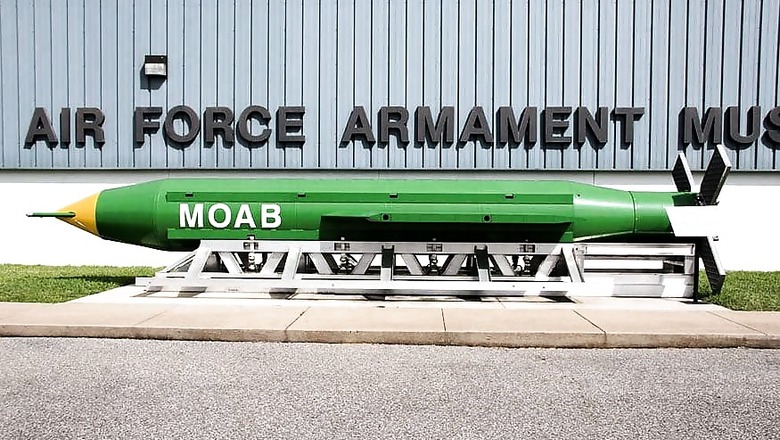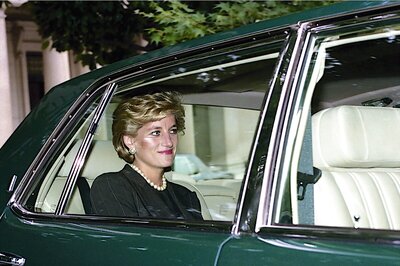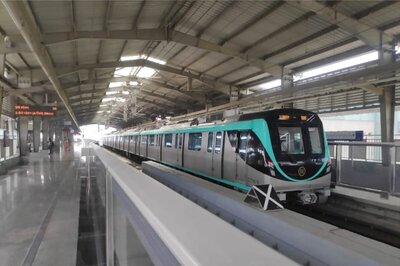
views
Achin: The top US military commander in Afghanistan said on Friday that the decision to deploy one of the largest conventional bombs ever used in combat was purely tactical, and made as part of the campaign against Islamic State-linked fighters.
As many as 36 suspected Islamic State militants were killed in the strike on Thursday evening in the eastern province of Nangarhar, Afghan defence officials said, adding there were no civilian casualties.
Amaq, the news agency affiliated with Islamic State in the Middle East, carried a statement denying that the group had suffered casualties in the attack, citing an unidentified source who had been in contact.
The statements could not be independently verified, and on Friday Afghan and foreign troops in the vicinity were not allowing reporters or locals to approach the scene of the blast.
The strike came as US President Donald Trump prepares to dispatch his first high-level delegation to Kabul, amid uncertainty about his plans for the nearly 9,000 American troops stationed in Afghanistan.
Nicholson said he was in constant communication with officials in Washington, but the decision to use the 21,600-pound (9,797-kg) GBU-43 bomb was based on his assessment of military needs and not broader political considerations.
"This was the first time that we encountered an extensive obstacle to our progress," he said of a joint Afghan-U.S. operation that has been targeting Islamic State since March.
"It was the right time to use it tactically against the right target on the battlefield."
Afghan and US forces were at the scene of the strike and reported that the "weapon achieved its intended purpose,", Nicholson said.
Afghan Defence Ministry spokesman Dawlat Waziri said no civilians were harmed in the massive blast that targeted a network of caves and tunnels that had been heavily mined.
"No civilian has been hurt and only the base, which Daesh used to launch attacks in other parts of the province, was destroyed," Waziri said in a statement.
He was using an Arabic term that refers to Islamic State, which has established a small stronghold in eastern Afghanistan and launched deadly attacks on the capital, Kabul.
The GBU-43 is a GPS-guided munition that had never before been used in combat since its first test in 2003 when it produced a mushroom cloud visible from 20 miles (32 km) away.
The bomb's destructive power, equivalent to 11 tonnes of TNT, pales in comparison with the relatively small atomic bombs dropped on Japan at the end of World War Two, which had blasts equivalent to between 15,000 and 20,000 tonnes of TNT.
MIXED REACTIONS
In Achin village, about 3 miles (5 km) from the remote, mountainous area where the bomb was dropped, witnesses said the ground shook, but homes and shops appeared unaffected.
Qari Mehrajuddin first saw "lightning like a thunderstorm" followed by the roar of an explosion, an all-to-familiar sound for residents of the war-torn area.
"I thought there was a bombing just outside my home," he said. In reality, the blast was around three miles away, its massive impact bigger than any before seen in the region.
Some locals welcomed the strike.
"If you want to destroy and eliminate Daesh, then even if you destroy my home we won't complain, because they are not human beings, they are savages," said Mir Alam Shinwari, using an Arabic term for Islamic State.
Away from Achin, reactions were mixed.
"The fact is that America used their big bomb here to test its effectiveness," said Kabul resident Asadullah Khaksar. "If America wants to eliminate Daesh, it is very easy because they created this group."
Residents of Achin said they had got used to seeing militants climbing up and down the mountain, making occasional visits to the village.
"They were Arabs, Pakistanis, Chinese and local insurgents coming to buy from shops in the bazaar," said Raz Mohammad.
"TESTING GROUND"
On Friday, the village was swarming with Afghan and international troops, as helicopters and other aircraft flew overhead.
Afghan President Ashraf Ghani's office said in a statement the attack was a part of a joint operation by Afghan and international troops.
"Afghan and foreign troops closely coordinated this operation and were extra cautious to avoid any civilian casualties," it said.
But former president Hamid Karzai condemned the use of the weapon on Afghan soil.
The Taliban, the main security threat to Afghan and NATO forces trying to quell their stubborn insurgency, also denounced the bombing.
"Using this massive bomb cannot be justified and will leave a material and psychological impact on our people," the Taliban, who compete with Islamic State in Afghanistan, said in a statement.
American officials said the bomb had been positioned for possible use in Afghanistan for "some time" since the administration of former president Barack Obama.
The United States has steadily intensified its air campaign against Islamic State and Taliban militants in Afghanistan, with the Air Force deploying nearly 500 weapons in the first three months of 2017, up from 300 in the corresponding 2016 period.
Thursday's strike was not the first time Islamic State fighters have been targeted by heavy American bombardment in Nangarhar, where a U.S. special forces soldier was killed battling militants a week ago.
Last year, B-52 bombers operating out of Qatar flew at least two missions in Afghanistan for the first time since 2006.
Such aircraft can carry as much as 70,000 pounds (32,000 kg)of bombs, missiles, or other weapons on each mission.
In March, U.S. forces conducted 79 "counterterror strikes" against Islamic State in Nangarhar, killing as many as 200 militants, according to the U.S. military command in Kabul.
U.S. military officials estimate there are about 600 to 800 Islamic State fighters in Afghanistan, mostly in Nangarhar, but also in the neighbouring province of Kunar.
The United Nations has raised concerns that the American air campaign is swelling civilian casualties in Afghanistan.

















Comments
0 comment